Forget break-out spaces and collaboration zones, many civil service offices of the past were ugly, impractical and unpleasant to work in. Jim Dunton explores the history of some of government’s most notorious buildings – and pays homage to some of the pioneering ones too
We might not spend quite as much time working from them as we used to, but our offices have the power to shape us for better or worse. As a great philosopher once observed, working nine to five is “enough to drive you crazy if you let it”.
The Cabinet Office has been on a mission to reduce the size of the government’s central London estate for some time now. In 2020, the Places for Growth programme set a goal of relocating 22,000 roles from the capital to other parts of the country by the end of the decade. It actually hit its target last year. This week, the department announced that the number of civil servants working in the capital will drop from the current 95,000 full-time equivalent staff to 83,000 by 2030.
As part of the process, more workplaces will be vacated – including the Department of Health and Social Care’s 39 Victoria Street HQ, the Department for Work and Pensions’ Caxton House base and the Ministry of Justice’s headquarters.
It’s easy to forget that there has always been change in Whitehall and beyond. Many who work in the Home Office’s 2 Marsham Street headquarters – also home to the Ministry of Housing, Communities and Local Government and the Department for Environment, Food and Rural Affairs – will be unaware of the legendarily unpopular buildings it replaced.
Marsham Towers featured three 20-storey blocks linked by a podium. They were originally intended to be the base for three separate departments – education and science, housing, and local government. But the buildings eventually served primarily as the headquarters of the Department of the Environment from 1972 to 1995.
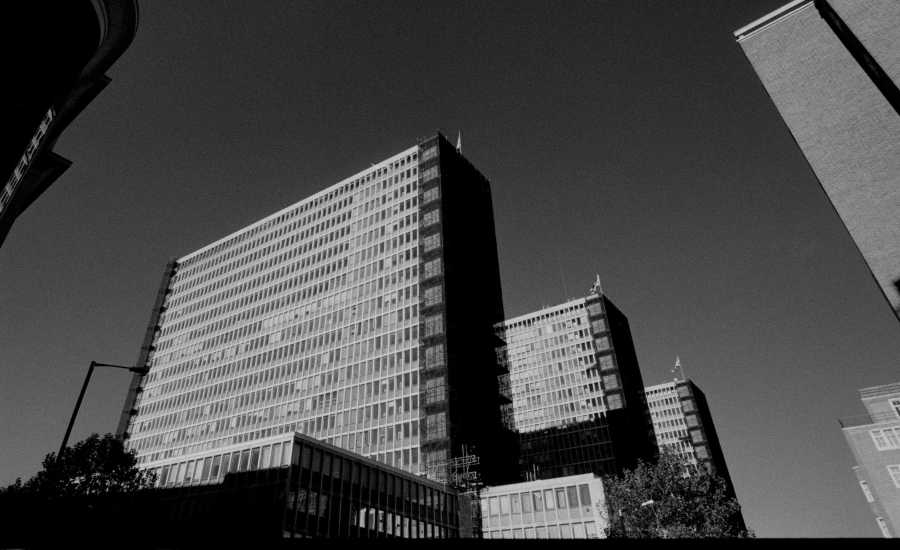 The now-demolished Marsham Towers. Photo: Brian Harris/Alamy Stock Photo
The now-demolished Marsham Towers. Photo: Brian Harris/Alamy Stock Photo
Commissioned in the 1960s at a time when opposition to high-rise development in the capital had yet to manifest itself, the completed building loomed oppressively in views of the Houses of Parliament and earned itself the nicknames “the three ugly sisters”, “faulty towers” and “the triple toast rack”.
Significant problems included regulating temperatures inside the highly glazed buildings to cope with summer sunshine and the chills of December and January – which left the offices “steaming hot during the summer, and freezing cold in the winter”, according to a 2002 analysis by English Heritage.
Moving a single department into a building originally designed for three separate government entities subjected DoE staff to lengthy walks through the building’s three miles of corridors and reliance on lifts. The towers also lacked toilets on every floor.
In December 1993, then-environment secretary John Gummer – now Lord Deben – told the Financial Times his departmental headquarters was “staggeringly and revoltingly offensive”. He added: “It is ugly, unsympathetic, unhygienic and unsafe ... It’s the most depressing place I’ve ever worked in.”
Fellow former environment secretary Michael – now lord – Heseltine told Construction News in 2000 it was “ironic” that DoE officials used to pass judgment on the aesthetic merits of planning applications “while sitting in one of the capital’s worst eyesores”.
Overseeing architect Eric Bedford – who also designed the BT Tower – defended the offices as “a utilitarian building”. “We never said what we were producing was an architectural object, there was no money there,” he told Building magazine in 1992.
Emily Cole, author of the Historic England appraisal of Marsham Towers, said questions about why the blocks had ever been permitted were usually answered with the response that any building was seen as an improvement on the derelict gasworks that occupied the site before.
The current buildings at 2 Marsham Street were designed by Sir Terry Farrell, whose practice is also responsible for the MI6 building at Vauxhall. He said both structures proved “groundscrapers” could contain as much floorspace as towers on a given site – and be “much more efficient and effective in terms of containing a community”. He added that dense low-rise buildings are also much more economic in energy use. Both make extensive use of atriums to give staff “light and views”.
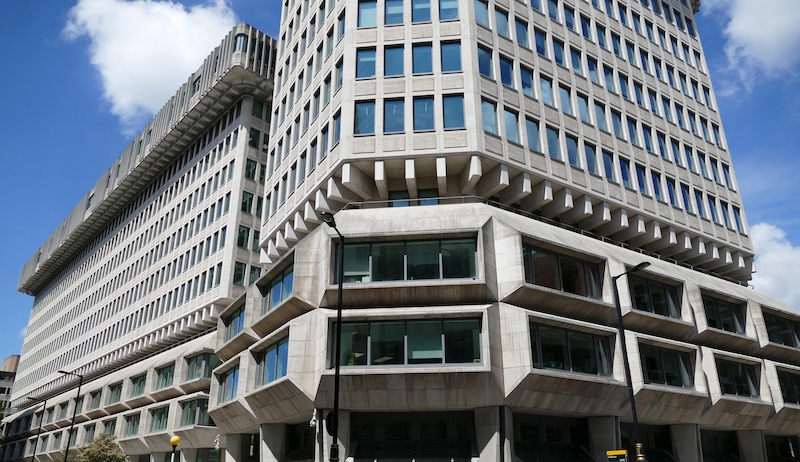 102 Petty France. Photo: World History Archive/Alamy Stock Photo
102 Petty France. Photo: World History Archive/Alamy Stock Photo
While the Home Office dodged the triple-pronged pain of Marsham Towers, it was unable to escape the clinches of brutalism. By the late 1970s, it was based at the newly-constructed (and somewhat phallic) 50 Queen Anne’s Gate building – now home to the MoJ and renamed 102 Petty France.
Designed by Fitzroy Robinson & Partners in conjunction with modernist architect Sir Basil Spence – responsible for the grade I-listed Coventry Cathedral – the 14-storey building also had its detractors. One silver lining, however, may have been that the fortress-like structure replaced an equally unpopular Victorian mansion block.
Jack Straw, who served as New Labour’s first home secretary from 1997 to 2001, was unflinching in his criticism of the building and likened it to the former KGB headquarters in Moscow. “It was awful in those days,” he told a BBC documentary in 2009. “We used to call it the Lubyanka. It was like a prison and it had little cells off it. There was a car park which was windswept and litter-strewn. In those days, you would go up in the ministerial lift – you had your own loo – and with a bit of luck you would never be contaminated by any other form of human life, except in a meeting, and then go down in the lift and leave.”
“It was awful in those days. It was like a prison and it had little cells off it” former justice secretary Jack Straw on the MoJ’s Petty France HQ before it became open-plan
Straw did not broach his delight at returning to the building when he was appointed lord chancellor and justice secretary in 2007. But by that point the block had been completely stripped out and refurbished with open-plan offices.
Lord St John of Fawsley – better known as Norman St John Stevas, Margaret Thatcher’s first leader of the House of Commons – was more vitriolic over Spence’s impact on the London skyline in a 2004 House of Lords debate. He said the architect’s work on 50 St Anne’s Gate, which overlooks St James’s Park and Hyde Park Barracks in Knightsbridge gave Spence the rare distinction of having “ruined two parks”.
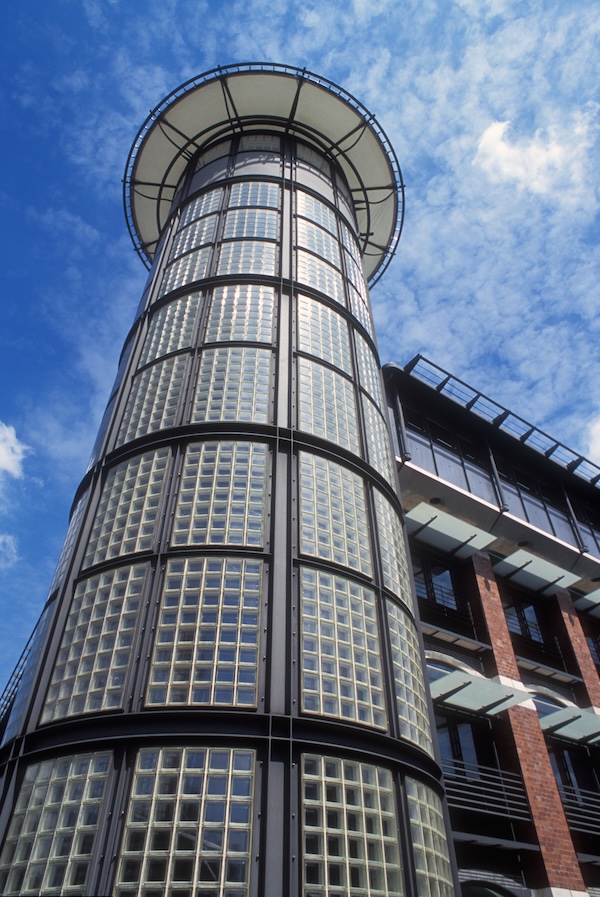 The Inland Revenue Centre. Photo: eye35 stock/Alamy Stock Photo
The Inland Revenue Centre. Photo: eye35 stock/Alamy Stock Photo
One recently-vacated government office development of the modern era has received somewhat higher praise. In May 2023, the Department for Culture, Media and Sport approved a proposal to list Michael Hopkins & Partners’ Inland Revenue Centre at Castle Meadow, in Nottingham, at grade II. HM Revenue and Customs had already relocated staff to its new Unity Square base in the city, but the listing decision was a glowing endorsement of the Castle Meadow scheme’s credentials.
The campus is the result of a 1989 decision by the then-Inland Revenue to relocate close to 2,000 roles out of London (sound familiar?), partly in response to the rising cost of office space. Local opposition to its original plans were focused on their impact on Nottingham Castle and led Inland Revenue to take the unusual step of running a design competition to find an alternative scheme.
Hopkins’ winning proposals brought together six low-rise office buildings and a tent-roofed amenity building with a sports court and restaurants. Its successful listing recognises its status as a pioneering sustainable complex that was the first British project to receive maximum credits under the then newly-established BREEAM environmental assessment.
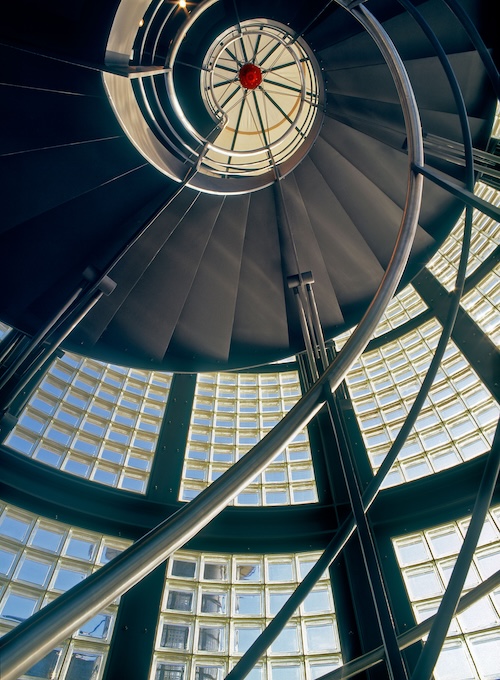 Spiral staircase detail at the Inland Revenue Centre. Photo: Aardvark/Alamy Stock Photo
Spiral staircase detail at the Inland Revenue Centre. Photo: Aardvark/Alamy Stock Photo
The Inland Revenue Centre featured triple-glazed windows and a range of measures to help regulate the internal temperature. The office buildings’ glassblock stair towers formed part of the ventilation system, using solar gain to draw warm air upwards and expelling it around the edges of the fabric-covered roofs.
The University of Nottingham bought Castle Meadow to transform it into a centre for final-year students and postgraduates. Its newly-acquired listed status will require the building’s owners to be respectful of the campus’ special characteristics. But it does not entirely protect the buildings from future demolition, if a strong enough case can be made.
***
Most denizens of the modern office occasionally long for a return to simpler times, when Microsoft Teams could not demand an immediate videoconference and a slew of important emails could not drop minutes before the onset of a bank-holiday weekend. But days of yore were not without their challenges.
A Ministry of Defence publication from the early 2000s describes the Victorian-era War Office as having a reputation for poor facilities and sickly staff. It cites a newspaper report from the 1860s ranking the danger faced by staff “at about the same level as an Ashantee campaign”.
Communications were also an issue. According to the MoD, 17% of staff working in the Pall Mall War Office were messengers tasked with maintaining the flow of information between what was a series of linked houses and outposts further afield.
By 1914, there was a new War Office on Whitehall – confusingly known today as the Old War Office – designed by William Young, Clyde Young and Sir John Taylor, and delivered at a cost of £1.2m. While the building’s facilities may have been an improvement on Pall Mall, chaos was not banished. The MoD history describes the building’s bustle as resembling “Liverpool Street Station on the evening of a rainless bank holiday”.
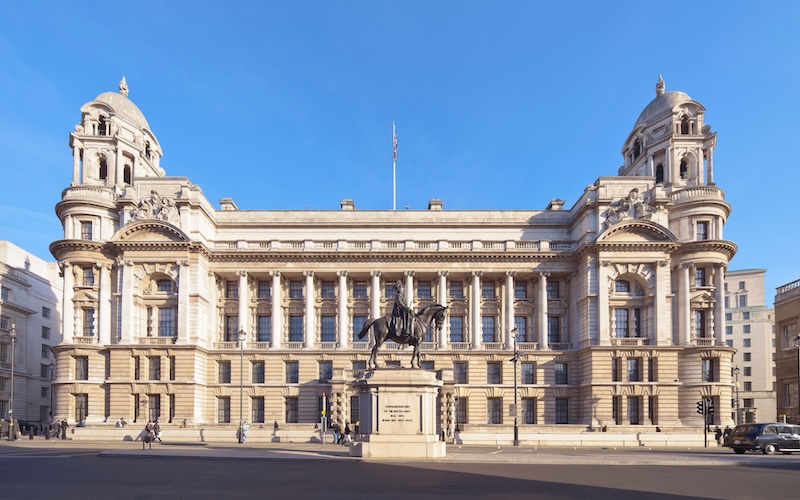 The Old War Office. Photo: Nikreates/Alamy Stock Photo
The Old War Office. Photo: Nikreates/Alamy Stock Photo
At the time of the Great War, Boy Scouts were employed as additional messengers. One account describes efforts to track down a newly appointed colonel believed to be in the building as requiring three days and three different runners.
The war was also a time of friction between civil servants – or “frocks” – and “uniforms”, with military personnel often suspecting their non-enlisted colleagues of treacherous intent.
The Old War Office hosted secretaries of state from Kitchener of Khartoum to Winston Churchill and John Profumo, as well as being a stomping ground for TE Lawrence (aka Lawrence of Arabia) and Ian Fleming, creator of James Bond.
It served as the Army’s administrative HQ until the creation of the unified MoD in 1964, when much of its work moved over to the Main Building in Horse Guards Avenue. Nevertheless, the Old War Office remained in use for several more decades.
Former Government Property Agency chair Liz Peace worked in the building as a new recruit to the civil service in the 1970s. “It was like working in a garret. The roof leaked and water poured down the windows every time it rained,” she told CSW in 2019. “You were only entitled to carpet if you were a certain grade so if they changed the grade of who occupied the office, the carpet would be ripped up, which left a mess.”
“In the Old War Office, you were only entitled to carpet if you were a certain grade so if they changed the grade of who occupied the office, the carpet would be ripped up, which left a mess” former GPA chair Liz Peace
Those days are long gone. In 2016, the grade II* building was bought on a 250-year lease by the Hinduja Group. In addition to the £350m acquisition price, the business has spent a further £1bn converting it into a luxury hotel and 85 exclusive apartments. The hotel – Raffles at the OWO – opened in September 2023.
Officials fearful that a similar selloff-and-redevelop fate could await their cherished central-London base were able to take some comfort from comments made by then-GPA chief executive Steven Boyd in 2023. He told MPs on the Public Administration and Constitutional Affairs Committee that the government did not want to sell any more historic Whitehall offices.
The GPA’s current plan is for the Whitehall estate to comprise just 16 buildings by 2030. While many of the high-profile disposals aimed at getting to that figure have already taken place, much uncertainty remains about how the nine-to-five of the future will look for civil servants.
Have you worked at any of the buildings listed above – or others that we should have included? Share your memories, good or bad, with jessica.bowie@civilserviceworld.com
- This is an updated version of a feature that originally appeared in Civil Service World's Autumn 2023 edition